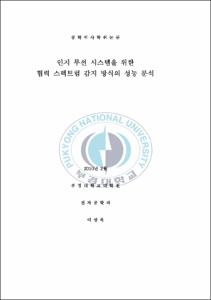인지 무선 시스템을 위한 협력 스펙트럼 감지 방식의 성능 분석
- Abstract
- 인지 무선(cognitive radio) 네트워크에서 협력 스펙트럼 감지(cooperative spectrum sensing)는 다수의 부 사용자(secondary user)가 서로 협력하여 주 사용자(primary user)의 스펙트럼 사용 여부를 판단하는 방식으로서 페이딩으로 인한 스펙트럼 감지 성능의 저하 문제를 해소할 수 있는 유력한 수단으로 알려져 있다.
협력 스펙트럼 감지를 수행하는 일반적인 형태는 부 사용자가 주 사용자의 스펙트럼 사용 여부를 일차적으로 판정하고 그 결과를 융합 센터(fusion center)로 전송하면 융합 센터는 이를 토대로 최종적으로 판정하는 것이다. 융합 센터에서는 부 사용자들의 판정을 종합하여 최종 판정을 내리는데 이 때 사용할 수 있는 가장 일반적인 융합 규칙으로 k-out-of-n 규칙이 있다. 이 방식은 n명의 부 사용자 중에 k명 이상이 주 사용자가 해당 스펙트럼을 사용하고 있다는 것에 동의할 때에만 이를 최종 판단으로 확정하는 규칙으로 기존의 융합 규칙을 일반화한 것이라 할 수 있다. 본 논문에서는 먼저 주 사용자의 검파 확률을 일정 수준 이상으로 유지한다는 조건하에서 k-out-of-n 융합 규칙을 사용하는 협력 스펙트럼 감지 방식의 성능 분석 방식을 제시하고, 그 적용 사례로 10명의 부 사용자로 구성된 인지 무선 네트워크에 대한 수치 분석 결과를 제시하였다. 또한, 협력 스펙트럼 감지 구조에서 부 사용자의 데이터 전송량을 최대로 할 수 있는 스펙트럼 감지 시간 및 그에 따른 최대 전송 용량에 대한 연구 결과가 이미 발표된 바 있는데, 이 결과는 개별 부 사용자 단말과 융합 센터 사이에 이상적인 전송 채널을 전제로 한 것이어서 전송 오류에 따른 영향을 반영하지 않았다. 이에 부 사용자와 융합 센터간에 데이터 전송 환경을 이진 대칭 채널(binary symmetric channel)로 모델링한 후, 부 사용자가 확보할 수 있는 전송 용량과 이를 최대로 하는 스펙트럼 감지 시간을 분석하였다. 분석 결과 AND 융합 규칙을 사용하는 경우가 OR 융합 규칙을 사용하는 경우보다 전송 오류로 인한 전송 용량(throughput) 손실이 작은 것으로 나타났다.
Cooperative spectrum sensing allows secondary users of a cognitive radio(CR) network to collaborate to determine whether a primary user occupies the spectrum of interest or not. It has been recognized as a promising technique to reduce the performance degradation of spectrum sensing in a fading environment.
A popular way of cooperative spectrum sensing is that each secondary user performs spectrum sensing and transmits the associated decisions to a fusion center, which combines the decisions into a final one using some fusion rule. A most general form of the fusion rule is the k-out-of-n fusion rule. This rule declares that the spectrum is occupied only when the decisions from more than k-1 secondary users indicate the presence of a primary user. In this paper, we analyze a cooperative spectrum sensing scheme with the fusion rule under the constraint that its detection probability is maintained to be no less than a given level and present the corresponding numerical results for the case of a CR network with 10 secondary users. Also, there has been an effort to investigate the optimal spectrum sensing interval for maximum throughput for a CR network with cooperative spectrum sensing. This is based on an assumption that the communication channels between each secondary user and the fusion center are ideal and error-free. Motivated by this, we model the channels as binary symmetric channels and examined the effect of the transmission error probability on the maximum throughput and the associated optimal sensing duration. Analysis shows that the performance degradation due to the transmission error is smaller for the case of using the AND fusion rule than for the ORfusion rule.
- Issued Date
- 2010
- Awarded Date
- 2010. 2
- Type
- Dissertation
- Publisher
- 부경대학교
- Files in This Item:
-
-
Download
 인지 무선 시스템을 위한 협력 스펙트럼 감지 방식의 성능 분석.pdf
기타 데이터 / 1.04 MB / Adobe PDF
인지 무선 시스템을 위한 협력 스펙트럼 감지 방식의 성능 분석.pdf
기타 데이터 / 1.04 MB / Adobe PDF
-
Items in Repository are protected by copyright, with all rights reserved, unless otherwise indicated.